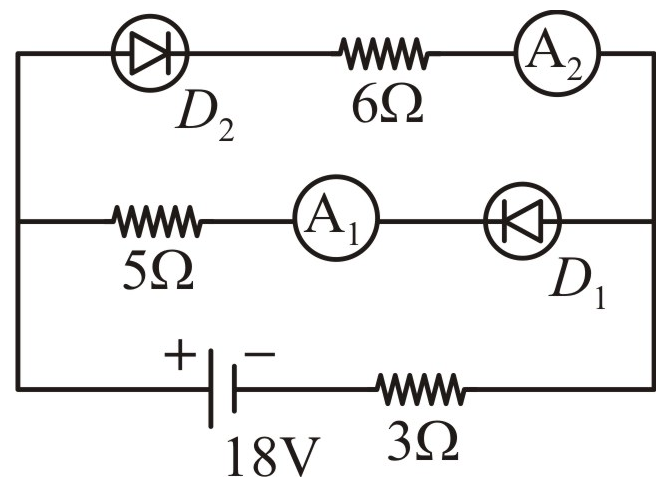In the energy band diagram of a material shown below, the open circles and filled circles denote holes and electrons respectively. The material is a/an:
| 1. | \(\mathrm{p}\text-\)type semiconductor |
| 2. | insulator |
| 3. | metal |
| 4. | \(\mathrm{n}\text-\)type semiconductor |
| 1. | The resistivity of a semiconductor increases with an increase in temperature. |
| 2. | Substances with an energy gap of the order of \(10\) eV are insulators. |
| 3. | In conductors, the valence and conduction bands may overlap. |
| 4. | The conductivity of a semiconductor increases with an increase in temperature. |
Carbon, Silicon, and Germanium atoms have four valence electrons each. Their valence and conduction bands are separated by energy gaps represented by \(\left(E_g\right)_C,(E_g)_{Si}~\text{and}~(E_g)_{Ge}\) respectively. Which one of the following relationships is true in their case?
| 1. | \(\left(E_g\right)_C<\left(E_g\right)_{G e} \) | 2. | \(\left(E_g\right)_C>\left(E_g\right)_{S i} \) |
| 3. | \(\left(E_g\right)_C=\left(E_g\right)_{S i} \) | 4. | \(\left(E_g\right)_C<\left(E_g\right)_{S i}\) |
1. \(6000~\mathring{A}\)
2. \(4000\) nm
3. \(6000\) nm
4. \(4000~\mathring{A}\)
A semiconductor is known to have an electron concentration of \(8\times 10^{13}~\text{cm}^{-3}\) and a hole concentration of \(5\times 10^{2}~\text{cm}^{-3}\). The semiconductor is:
| 1. | \(\mathrm{n}\text-\)type | 2. | \(\mathrm{p}\text-\)type |
| 3. | intrinsic | 4. | insulator |
| 1. | in the case of \(C\), the valence band is not completely filled at absolute zero temperature. |
| 2. | in the case of \(C\), the conduction band is partly filled even at absolute zero temperature. |
| 3. | the four bonding electrons in the case of \(C\) lie in the second orbit, whereas in the case of \(Si\), they lie in the third. |
| 4. | the four bonding electrons in the case of \(C\) lie in the third orbit, whereas for \(Si\), they lie in the fourth orbit. |
| 1. | \(\mathrm{n}\text-\)type with electron concentration \(n_{e}=5\times10^{22}~\text{m}^{-3}\) |
| 2. | \(\mathrm{p}\text-\)type with electron concentration \(n_{e}=2.5\times10^{23}~\text{m}^{-3}\) |
| 3. | \(\mathrm{n}\text-\)type with electron concentration \(n_{e}=2.5\times10^{10}~\text{m}^{-3}\) |
| 4. | \(\mathrm{p}\text-\)type with electron concentration \(n_{e}=5\times10^{9}~\text{m}^{-3}\) |
If the reverse bias in a junction diode is changed from \(5\) V to \(15\) V then the value of current changes from \(38~\mu \text{A}\) to \(88~\mu \text{A}\). The resistance of junction diode will be:
1. \(4\times10^{5}\)
2. \(3\times10^{5}\)
3. \(2\times10^{5}\)
4. \(10^{6}\)
The given circuit has two ideal diodes connected as shown in the figure below. The current flowing through the resistance \(R_1\) will be:
| 1. | \(2.5\) A | 2. | \(10.0\) A |
| 3. | \(1.43\) A | 4. | \(3.13\) A |
1. \(2\) A and zero
2. \(3\) A and \(2\) A
3. \(2\) A and \(3\) A
4. zero and \(2\) A





